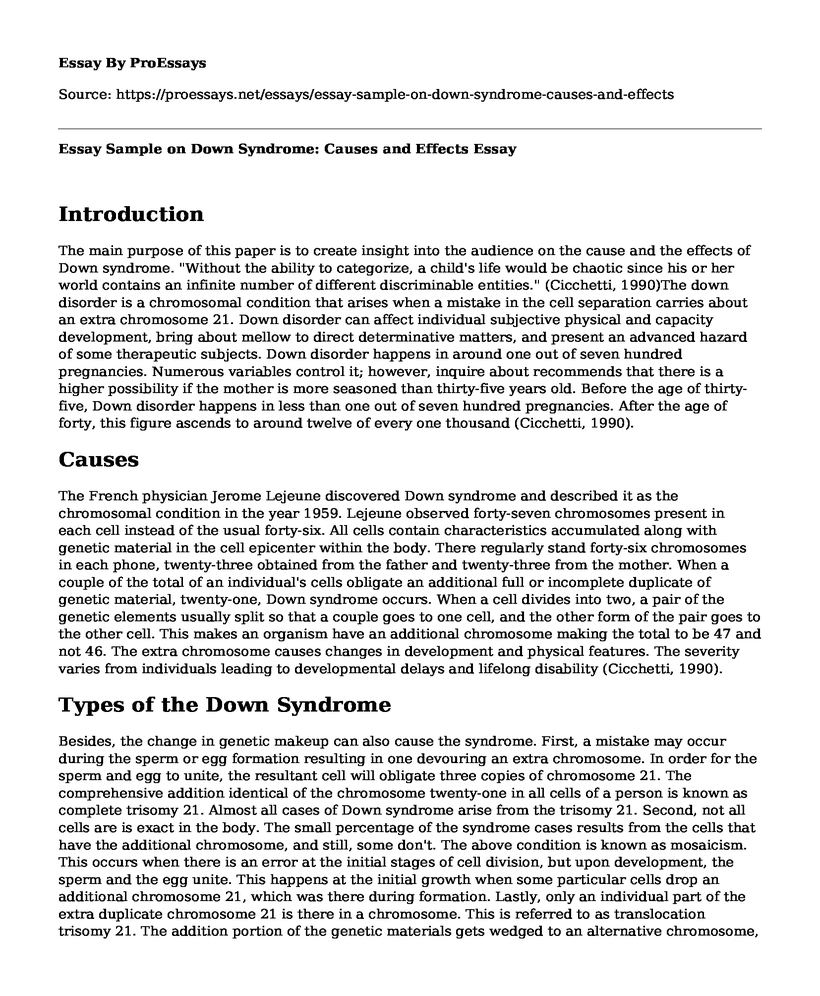Introduction
The main purpose of this paper is to create insight into the audience on the cause and the effects of Down syndrome. "Without the ability to categorize, a child's life would be chaotic since his or her world contains an infinite number of different discriminable entities." (Cicchetti, 1990)The down disorder is a chromosomal condition that arises when a mistake in the cell separation carries about an extra chromosome 21. Down disorder can affect individual subjective physical and capacity development, bring about mellow to direct determinative matters, and present an advanced hazard of some therapeutic subjects. Down disorder happens in around one out of seven hundred pregnancies. Numerous variables control it; however, inquire about recommends that there is a higher possibility if the mother is more seasoned than thirty-five years old. Before the age of thirty-five, Down disorder happens in less than one out of seven hundred pregnancies. After the age of forty, this figure ascends to around twelve of every one thousand (Cicchetti, 1990).
Causes
The French physician Jerome Lejeune discovered Down syndrome and described it as the chromosomal condition in the year 1959. Lejeune observed forty-seven chromosomes present in each cell instead of the usual forty-six. All cells contain characteristics accumulated along with genetic material in the cell epicenter within the body. There regularly stand forty-six chromosomes in each phone, twenty-three obtained from the father and twenty-three from the mother. When a couple of the total of an individual's cells obligate an additional full or incomplete duplicate of genetic material, twenty-one, Down syndrome occurs. When a cell divides into two, a pair of the genetic elements usually split so that a couple goes to one cell, and the other form of the pair goes to the other cell. This makes an organism have an additional chromosome making the total to be 47 and not 46. The extra chromosome causes changes in development and physical features. The severity varies from individuals leading to developmental delays and lifelong disability (Cicchetti, 1990).
Types of the Down Syndrome
Besides, the change in genetic makeup can also cause the syndrome. First, a mistake may occur during the sperm or egg formation resulting in one devouring an extra chromosome. In order for the sperm and egg to unite, the resultant cell will obligate three copies of chromosome 21. The comprehensive addition identical of the chromosome twenty-one in all cells of a person is known as complete trisomy 21. Almost all cases of Down syndrome arise from the trisomy 21. Second, not all cells are is exact in the body. The small percentage of the syndrome cases results from the cells that have the additional chromosome, and still, some don't. The above condition is known as mosaicism. This occurs when there is an error at the initial stages of cell division, but upon development, the sperm and the egg unite. This happens at the initial growth when some particular cells drop an additional chromosome 21, which was there during formation. Lastly, only an individual part of the extra duplicate chromosome 21 is there in a chromosome. This is referred to as translocation trisomy 21. The addition portion of the genetic materials gets wedged to an alternative chromosome, thereby conveyed in other cells as cells split. The above category of chromosomal modification causes few cases of the syndrome (Cicchetti, 1990).
Infants Born with the Condition
About six thousand infants are born with Down syndrome in the United States. It's only one infant out of seven hundred infants that are estimated to this condition. The approximated spread of this condition is between 1 in 1,000 to 1,100 births worldwide, according to the World Health Organization (Cicchetti, 1990)
The Stand of Down Syndrome with the Society
Children with this syndrome may have a slower growth rate of motor skills. The delayed motor development reduces the opportunities for infants in learning and exploring the world around hence affecting their cognitive development. Due to their low level of intelligence, they are less valued in society and fell unwanted in society. The people who have this type of condition have a small head, flattened face, protruding tongue, short neck, deprived muscle tone, shorthand and mounting slanting eyelids (Toffalini, 2018).
Conclusion
Down syndrome is a congenital disability that has enormous social and medical costs. It's one of the most prevalent genetic disorders worldwide and a popular genetic cause of limitations in the intellectual level in the newborns. When I was born,
Works Cited
Cicchetti, Dante, and Marjorie Beeghly, eds. Children with Down syndrome: A developmental perspective. Cambridge University Press, 1990.
Toffalini, E., et al. "Environment learning from virtual exploration in individuals with down syndrome: the role of perspective and sketch maps." Journal of Intellectual Disability Research 62.1 (2018): 30-40.
Cite this page
Essay Sample on Down Syndrome: Causes and Effects. (2023, Jun 06). Retrieved from https://proessays.net/essays/essay-sample-on-down-syndrome-causes-and-effects
If you are the original author of this essay and no longer wish to have it published on the ProEssays website, please click below to request its removal:
- Low Birth Weight of Vietnamese Infants: Article Analysis
- Essay Example on Medical Ethics
- Postgraduate Dentistry Personal Statement
- Paper Example on Standing Desks: The Way to Reduce Diabetes Cases in Schools
- Research Paper on Wearable Tech History and Its Impact on Healthcare
- Essay Sample on Nursing: From Submissive to Art & Science
- Anemia: Causes, Forms and Symptoms - Essay Sample







